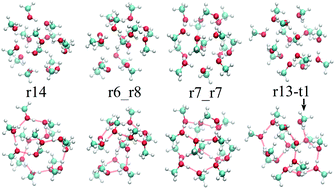Exploration of hydrogen bond networks and potential energy surfaces of methanol clusters using a two-stage clustering algorithm†
Abstract
The potential energy surface (PES), structures and thermal properties of methanol clusters (MeOH)n with n = 8–15 were explored by replica-exchange molecular dynamics (REMD) simulations with an empirical model and refined using density functional theory (DFT) methods. For a given size, local minima structures were sampled from REMD trajectories and archived by a newly developed molecular database via a two-stage clustering algorithm (TSCA). Our TSCA utilizes both the topology of O–H⋯O hydrogen bonding networks and the similarity of the shapes to filter out duplicates. The screened molecular database contains only distinct conformers sampled from REMD and their structures are further optimized by the two DFT methods with and without dispersion correction to examine the influence of dispersion on their structures and binding energies. Inspecting different O–H⋯O networks, the binding energies of methanol clusters are highly degenerated. The degeneracy is more significant with the dispersion effect that introduces weaker but more complex C–H⋯O bonds. Based on the structures we have searched, we were able to extract general trends and these datasets can serve as a starting point for further high-level ab initio calculations to reveal the true energy landscape of methanol clusters.



 Please wait while we load your content...
Please wait while we load your content...